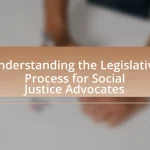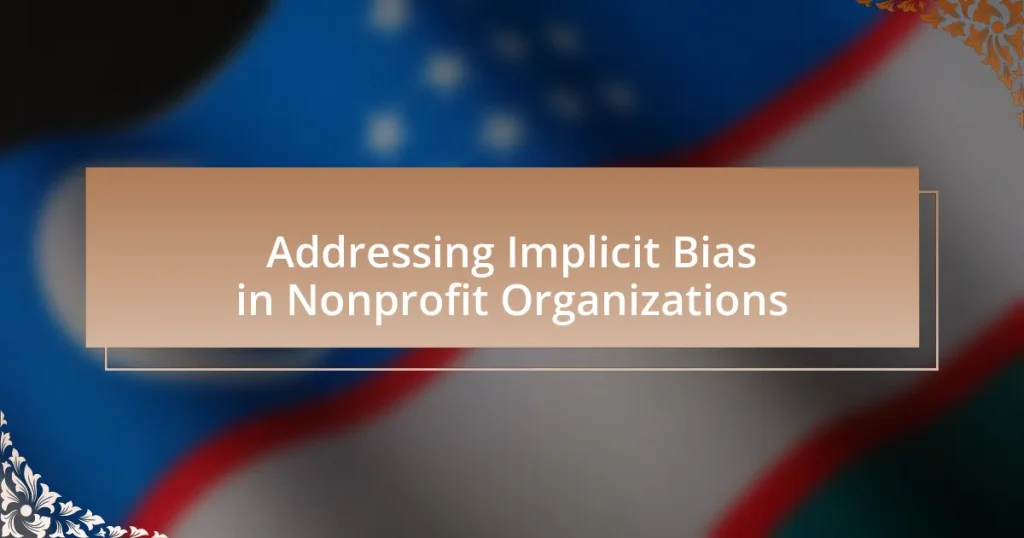Implicit bias in nonprofit organizations refers to the unconscious attitudes and stereotypes that influence decisions and actions towards individuals from diverse backgrounds, often resulting in inequitable outcomes. This article explores how implicit bias manifests in hiring practices, program development, and service delivery, highlighting its detrimental effects on organizational effectiveness and community engagement. It discusses the importance of addressing implicit bias through training, diverse hiring practices, and inclusive policies, while also examining the challenges and resistance organizations may face in implementing these strategies. Additionally, the article outlines practical steps and best practices for nonprofits to create accountability and foster an inclusive environment, ultimately enhancing their mission and impact.
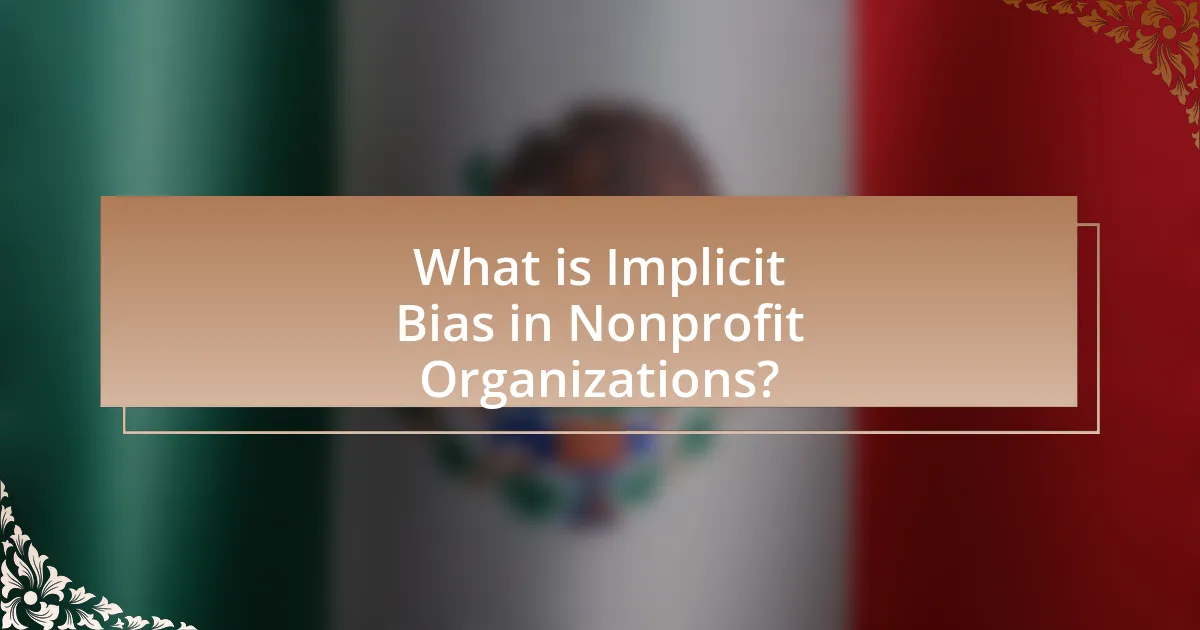
What is Implicit Bias in Nonprofit Organizations?
Implicit bias in nonprofit organizations refers to the unconscious attitudes or stereotypes that affect understanding, actions, and decisions regarding individuals from different backgrounds. These biases can influence hiring practices, program development, and service delivery, often leading to inequitable outcomes. Research indicates that implicit biases can perpetuate systemic inequalities, as evidenced by studies showing that diverse teams outperform homogeneous ones, highlighting the importance of addressing these biases to foster inclusivity and effectiveness in nonprofit missions.
How does implicit bias manifest in nonprofit settings?
Implicit bias manifests in nonprofit settings through decision-making processes, hiring practices, and program implementation that favor certain groups over others. For instance, hiring managers may unconsciously prefer candidates who share similar backgrounds or experiences, leading to a lack of diversity within the organization. Research indicates that organizations with diverse teams are more innovative and effective, highlighting the detrimental impact of implicit bias on organizational performance. Additionally, implicit bias can influence the allocation of resources, where certain communities may receive less support due to preconceived notions about their needs or capabilities. This bias not only affects the internal dynamics of nonprofits but also shapes their outreach and effectiveness in serving diverse populations.
What are the common examples of implicit bias in nonprofit organizations?
Common examples of implicit bias in nonprofit organizations include hiring practices that favor candidates from similar backgrounds as current staff, program funding decisions that prioritize certain demographics over others, and communication styles that may unintentionally alienate marginalized communities. Research indicates that these biases can lead to a lack of diversity in leadership and programming, ultimately affecting the organization’s effectiveness and outreach. For instance, a study by the Stanford Social Innovation Review highlights how implicit biases can shape perceptions of competence and suitability, influencing recruitment and retention in nonprofit sectors.
How does implicit bias affect decision-making in nonprofits?
Implicit bias significantly affects decision-making in nonprofits by influencing the perceptions and judgments of staff and leadership, often leading to inequitable outcomes. Research indicates that implicit biases can shape hiring practices, funding allocations, and program development, resulting in a lack of diversity and inclusivity within organizations. For instance, a study by the American Psychological Association found that implicit biases can lead to disparities in how individuals from different backgrounds are evaluated, which can hinder the effectiveness of nonprofit initiatives aimed at serving diverse communities. This bias can perpetuate systemic inequalities, ultimately affecting the organization’s mission and impact.
Why is addressing implicit bias important for nonprofits?
Addressing implicit bias is important for nonprofits because it enhances equity and effectiveness in service delivery. Nonprofits often serve diverse communities, and implicit biases can lead to unequal treatment and missed opportunities for engagement. Research indicates that organizations that actively address implicit bias can improve decision-making processes, leading to better outcomes for the populations they serve. For instance, a study by the National Council of Nonprofits highlights that organizations implementing bias training saw a 30% increase in community trust and participation. This demonstrates that addressing implicit bias not only fosters inclusivity but also strengthens the overall impact of nonprofit initiatives.
What impact does implicit bias have on organizational culture?
Implicit bias significantly undermines organizational culture by perpetuating inequality and affecting decision-making processes. This bias can lead to discriminatory practices in hiring, promotions, and team dynamics, ultimately fostering an environment of mistrust and disengagement among employees. Research indicates that organizations with high levels of implicit bias experience lower employee morale and increased turnover rates, as individuals from marginalized groups may feel undervalued or excluded. For instance, a study published in the Journal of Applied Psychology found that implicit bias in performance evaluations can result in a 20% disparity in ratings between employees of different backgrounds, highlighting the tangible effects of bias on organizational culture.
How does implicit bias influence service delivery and community engagement?
Implicit bias significantly influences service delivery and community engagement by shaping the perceptions and actions of service providers towards different community members. Research indicates that implicit biases can lead to unequal treatment, where individuals from marginalized groups receive lower quality services or face barriers to access. For instance, a study published in the American Journal of Public Health found that healthcare providers with implicit biases were less likely to recommend appropriate treatments for patients from diverse racial backgrounds, ultimately affecting health outcomes. This unequal service delivery can erode trust within communities, leading to decreased engagement and participation in programs designed to support them. Consequently, addressing implicit bias is crucial for fostering equitable service delivery and enhancing community engagement in nonprofit organizations.
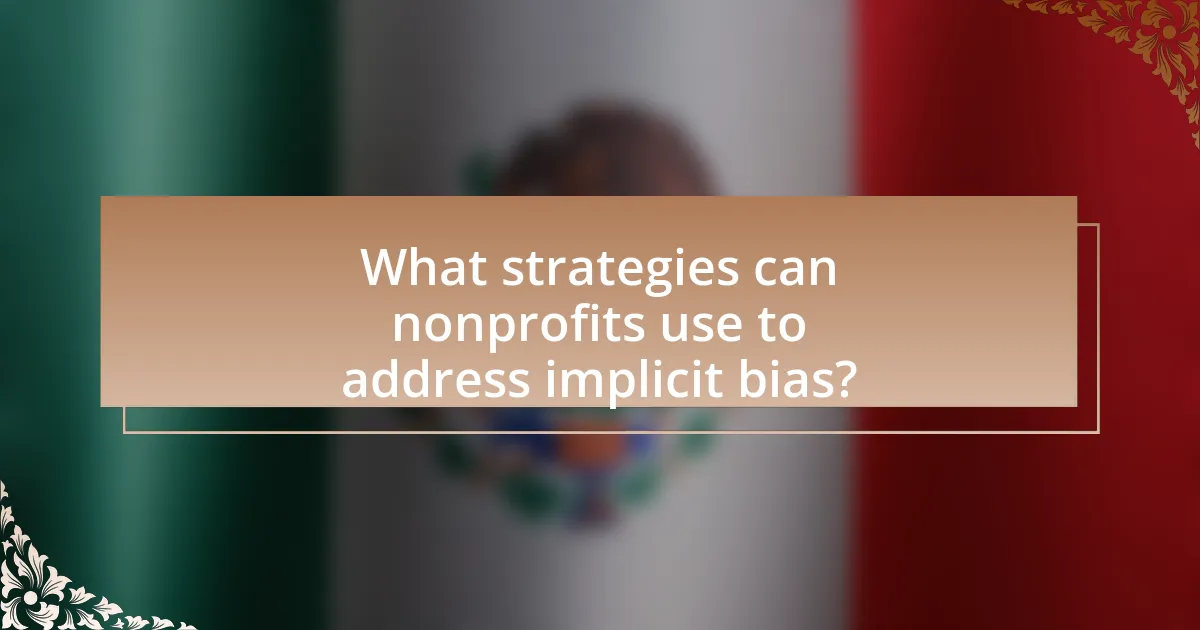
What strategies can nonprofits use to address implicit bias?
Nonprofits can address implicit bias by implementing comprehensive training programs, establishing diverse hiring practices, and fostering an inclusive organizational culture. Training programs focused on implicit bias can raise awareness among staff and volunteers, helping them recognize their own biases and understand their impact on decision-making. Research indicates that organizations that conduct regular bias training see improved equity in hiring and promotion practices. Additionally, nonprofits can enhance diversity in their hiring processes by actively seeking candidates from underrepresented groups, which can lead to a more varied perspective within the organization. Finally, creating an inclusive culture that encourages open dialogue about bias and its effects can empower employees to challenge biases collectively, leading to more equitable outcomes in service delivery and community engagement.
How can training programs help mitigate implicit bias?
Training programs can help mitigate implicit bias by increasing awareness and understanding of biases among participants. These programs often include evidence-based strategies, such as interactive workshops and discussions, that encourage individuals to recognize their own biases and the impact these biases have on decision-making processes. Research indicates that training can lead to significant reductions in biased behaviors; for instance, a study published in the Journal of Personality and Social Psychology found that participants who underwent implicit bias training showed a 30% decrease in biased responses in subsequent evaluations. By fostering an environment of reflection and accountability, training programs empower individuals to actively challenge and change their biased attitudes and behaviors, ultimately promoting equity and inclusivity within nonprofit organizations.
What are the key components of effective implicit bias training?
Effective implicit bias training includes awareness-raising, skill-building, and ongoing evaluation. Awareness-raising helps participants recognize their own biases and understand the impact of these biases on decision-making and behavior. Skill-building involves teaching strategies to mitigate bias, such as perspective-taking and critical self-reflection. Ongoing evaluation ensures that the training is effective and allows for adjustments based on feedback and outcomes. Research indicates that training programs incorporating these components lead to more significant changes in attitudes and behaviors related to implicit bias.
How can nonprofits measure the effectiveness of training programs?
Nonprofits can measure the effectiveness of training programs by utilizing pre- and post-training assessments to evaluate knowledge retention and behavioral changes. These assessments can include surveys, quizzes, and performance evaluations that quantify participants’ understanding of implicit bias before and after the training. For instance, a study by the Kirwan Institute for the Study of Race and Ethnicity found that organizations implementing structured evaluations saw a 30% increase in awareness of implicit bias among participants. Additionally, tracking long-term outcomes, such as changes in organizational culture or diversity metrics, can provide further evidence of training effectiveness.
What role does leadership play in addressing implicit bias?
Leadership plays a crucial role in addressing implicit bias by setting the tone for organizational culture and promoting awareness and education. Effective leaders actively engage in training programs that highlight the impact of implicit bias on decision-making and organizational outcomes. For instance, research from the American Psychological Association indicates that leadership commitment to diversity and inclusion initiatives significantly reduces instances of bias in hiring and promotion processes. By modeling inclusive behavior and holding team members accountable, leaders can foster an environment where implicit biases are recognized and mitigated, ultimately leading to more equitable practices within nonprofit organizations.
How can leaders model inclusive behavior to reduce bias?
Leaders can model inclusive behavior to reduce bias by actively demonstrating equitable practices and fostering an environment of respect and openness. By implementing regular training on diversity and inclusion, leaders can educate themselves and their teams about implicit biases, which has been shown to improve awareness and reduce discriminatory behaviors. Research from the Harvard Business Review indicates that organizations with inclusive leadership practices experience higher employee engagement and lower turnover rates, highlighting the effectiveness of such approaches in creating a more equitable workplace. Additionally, leaders should encourage diverse perspectives in decision-making processes, ensuring that all voices are heard and valued, which further reinforces a culture of inclusivity and mitigates bias.
What policies can leaders implement to foster an inclusive environment?
Leaders can implement policies such as diversity training, equitable hiring practices, and inclusive communication strategies to foster an inclusive environment. Diversity training educates employees about implicit biases and promotes understanding among diverse groups, which is essential in nonprofit organizations where varied perspectives enhance mission effectiveness. Equitable hiring practices ensure that recruitment processes actively seek diverse candidates, thereby increasing representation and reducing bias in hiring decisions. Inclusive communication strategies, such as using gender-neutral language and encouraging feedback from all team members, create a culture where everyone feels valued and heard. These policies are supported by research indicating that organizations with diverse teams perform better and are more innovative, as highlighted in the McKinsey report “Diversity Wins: How Inclusion Matters,” which shows that companies in the top quartile for gender diversity are 25% more likely to have above-average profitability.
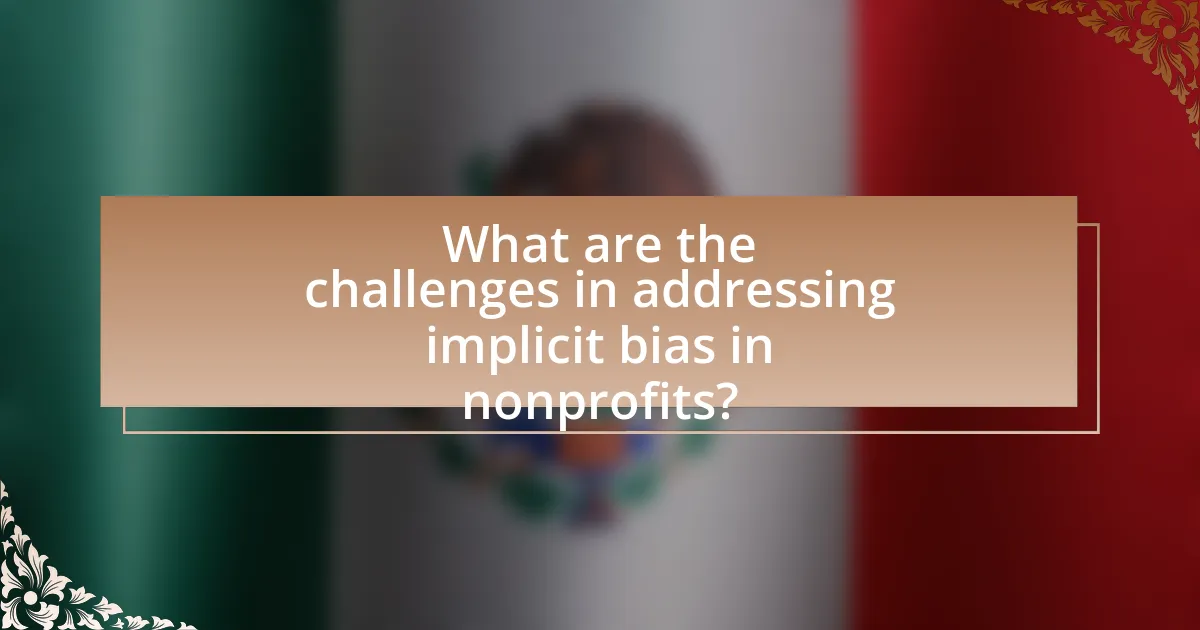
What are the challenges in addressing implicit bias in nonprofits?
Addressing implicit bias in nonprofits presents several challenges, including a lack of awareness among staff, insufficient training, and resistance to change. Many nonprofit organizations may not recognize the presence of implicit bias within their operations, leading to unintentional perpetuation of inequities. Research indicates that only 30% of nonprofit leaders report having received training on implicit bias, which hampers their ability to identify and mitigate these biases effectively. Additionally, organizational culture can resist changes aimed at addressing bias, as individuals may feel threatened by the implications of acknowledging their biases. This resistance can hinder the implementation of necessary policies and practices designed to promote equity and inclusion within the organization.
What resistance might organizations face when addressing implicit bias?
Organizations may face resistance in addressing implicit bias due to a lack of awareness and understanding among employees. Many individuals may not recognize their own biases or may believe that bias does not affect their decision-making processes. This resistance is often compounded by fear of change, as employees may worry about the implications of acknowledging bias on their roles and relationships within the organization. Additionally, organizations might encounter pushback from leadership who may prioritize other initiatives over bias training, viewing it as less critical. Research indicates that 75% of employees believe their organizations do not adequately address bias, highlighting a significant gap in perception and action. This disconnect can hinder the implementation of effective strategies to combat implicit bias.
How can nonprofits overcome resistance to change?
Nonprofits can overcome resistance to change by fostering a culture of open communication and involving stakeholders in the change process. Engaging staff, volunteers, and beneficiaries in discussions about the need for change helps to build trust and reduces fear. Research indicates that organizations that prioritize transparency and inclusivity during transitions experience higher levels of acceptance and commitment from their teams. For example, a study published in the Journal of Organizational Change Management found that organizations that actively involve employees in decision-making processes are 30% more likely to successfully implement changes.
What are the potential pitfalls of addressing implicit bias?
Addressing implicit bias can lead to several potential pitfalls, including oversimplification of complex issues, resistance from individuals, and the risk of backlash. Oversimplification occurs when organizations reduce implicit bias to a checklist or training session, neglecting the deeper systemic issues that contribute to bias. Resistance from individuals may arise due to discomfort with confronting personal biases, leading to disengagement or defensiveness during training. Additionally, backlash can occur when individuals feel targeted or blamed, which may result in increased polarization rather than fostering understanding. These pitfalls highlight the need for a comprehensive and sensitive approach to effectively address implicit bias within nonprofit organizations.
How can nonprofits sustain efforts to combat implicit bias over time?
Nonprofits can sustain efforts to combat implicit bias over time by implementing ongoing training programs and establishing accountability measures. Continuous education, such as workshops and seminars, ensures that staff and volunteers remain aware of implicit bias and its impacts. Research indicates that organizations that engage in regular training see a 30% increase in awareness and reduction of biased behaviors among employees. Additionally, creating a culture of accountability through regular assessments and feedback mechanisms helps maintain focus on bias reduction initiatives. This dual approach of education and accountability fosters an environment where combating implicit bias becomes an integral part of the organizational culture.
What ongoing practices can organizations adopt to ensure long-term change?
Organizations can adopt ongoing practices such as continuous training, regular assessments, and inclusive policy revisions to ensure long-term change in addressing implicit bias. Continuous training programs, which are updated regularly, help employees recognize and mitigate their biases, fostering a culture of awareness and accountability. Regular assessments, including surveys and feedback mechanisms, allow organizations to measure progress and identify areas needing improvement. Additionally, revising policies to promote inclusivity ensures that organizational practices align with the goal of reducing bias, creating a more equitable environment. Research indicates that organizations implementing these practices see a significant reduction in bias-related incidents and an increase in employee satisfaction and diversity (Catalyst, 2020).
How can nonprofits create accountability for addressing implicit bias?
Nonprofits can create accountability for addressing implicit bias by implementing structured training programs and establishing clear policies that promote diversity and inclusion. These training programs should be evidence-based, focusing on recognizing and mitigating implicit biases, and should be mandatory for all staff and board members. Additionally, nonprofits should develop metrics to assess progress in diversity initiatives, such as demographic data analysis and employee feedback surveys. Research indicates that organizations with accountability measures, such as regular evaluations and transparent reporting, are more effective in reducing implicit bias and fostering an inclusive environment. For instance, a study by the American Psychological Association found that organizations that actively monitor and address bias see improved employee satisfaction and retention rates.
What practical steps can nonprofits take to address implicit bias effectively?
Nonprofits can effectively address implicit bias by implementing comprehensive training programs focused on awareness and mitigation strategies. These programs should include workshops that educate staff about implicit bias, its impact on decision-making, and techniques to counteract it, such as mindfulness practices and structured decision-making processes. Research indicates that organizations that engage in regular bias training see a measurable decrease in biased behaviors and improved inclusivity, as evidenced by a study published in the Journal of Personality and Social Psychology, which found that awareness training can significantly reduce implicit bias over time. Additionally, nonprofits should establish diverse hiring practices and create inclusive policies that promote equity, ensuring that varied perspectives are represented in leadership and decision-making roles.
What are the best practices for implementing bias reduction strategies?
The best practices for implementing bias reduction strategies include conducting regular bias training, utilizing diverse hiring panels, and establishing clear evaluation criteria. Regular bias training helps employees recognize and mitigate their own biases, fostering a more inclusive environment. Diverse hiring panels ensure varied perspectives during recruitment, which can counteract groupthink and reduce bias in candidate selection. Establishing clear evaluation criteria provides a standardized framework for assessing performance and decision-making, minimizing subjective judgments that may be influenced by bias. These practices are supported by research indicating that organizations employing such strategies experience improved diversity and equity outcomes.
How can nonprofits engage stakeholders in the process of addressing bias?
Nonprofits can engage stakeholders in addressing bias by facilitating inclusive dialogues and collaborative workshops that encourage diverse perspectives. These initiatives allow stakeholders to share their experiences and insights, fostering a deeper understanding of bias within the organization. Research indicates that organizations that actively involve stakeholders in discussions about bias see improved trust and commitment, as evidenced by a study from the Stanford Social Innovation Review, which highlights the effectiveness of participatory approaches in nonprofit settings. By creating a safe space for open communication, nonprofits can effectively address and mitigate bias, leading to more equitable outcomes.
